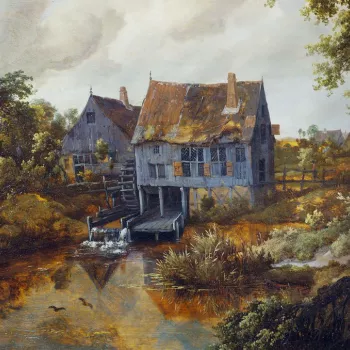A Shepherd Boy Asleep with a Cow and its Calf c.1660-65
Oil on panel | 25.9 x 34.0 cm (support, canvas/panel/stretcher external) | RCIN 404811
-
Born in Amsterdam, du Jardin is thought to have studied with Nicolaes Berchem and, although there is no documentation to prove it, he probably first went to Rome during the late 1640s. In 1650 he was in Paris but returned to Amsterdam in 1652 where he settled for a while, although he spent a few years from 1655 to 1658 in The Hague. In 1675 he returned to Italy in the company of Jan Reynst, the son of the famous Dutch merchant and art collector of the same name. Du Jardin’s nickname was Bokkebaert (Goatee-beard).
In contrast to the sunshine of A Muleteer and Two Men playing Morra (RCIN 406208), the sky here is stormy, the claustrophobic darkness setting a threatening tone. Du Jardin compositionally balances the sleeping boy with the resting cow. The wakefulness of the standing calf is intended to be eye-catching so that realisation dawns on the viewer, along with this animal, that the weather has altered and the shepherd should awaken and move to shelter.
This is drama of a rhythmical kind. There is no serious threat, and no sudden action. Instead the artist records the reality of nature, where changes in the weather can creep up steadily. The light in this painting is decidedly northern, with saturated greens and browns dominating and adding to the overall intensity of the atmosphere.
The similarity of du Jardin’s works to those of Paulus Potter is striking, and their paintings have often been confused.
Signed: 'K. DV. IARDIN'Provenance
Purchased by George IV from Sir Thomas Baring as part of a group of 86 Dutch and Flemish paintings, most of which were collected by Sir Thomas’s father, Sir Francis Baring; they arrived at Carlton House on 6 May 1814; recorded in the Bow Room, Ground Floor, at Carlton House in 1819 (no 115); in the Picture Gallery at Buckingham Palace in 1841 (no 11)
-
Medium and techniques
Oil on panel
Measurements
25.9 x 34.0 cm (support, canvas/panel/stretcher external)
40.7 x 49.0 x 4.0 cm (frame, external)
Category
Object type(s)
Other number(s)









